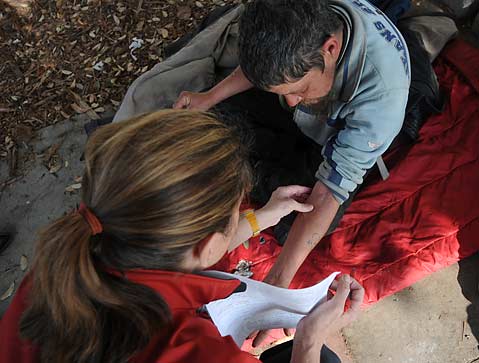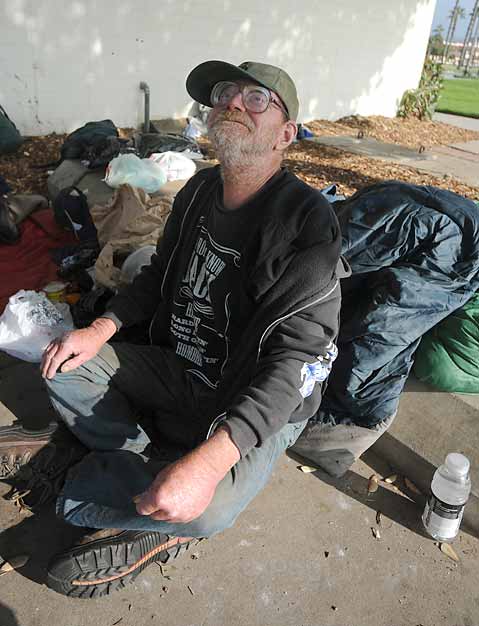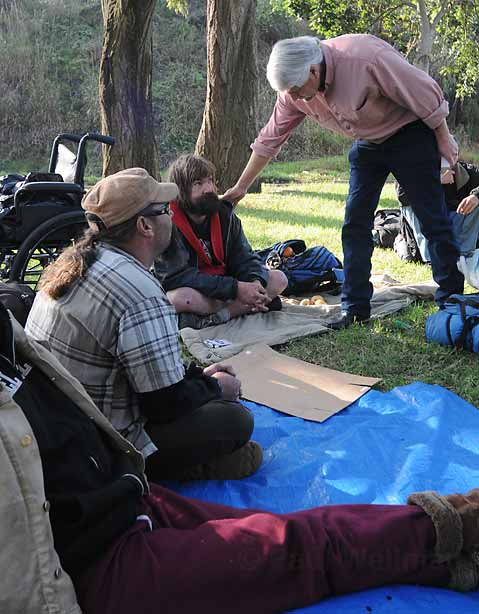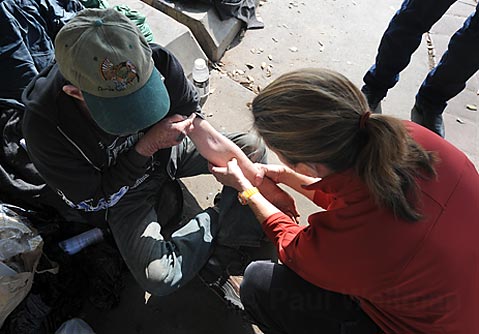Tuberculosis in Santa Barbara Homeless
Public Health Makes Plan of Attack to Stymie the Disease

Atreatable but worrisome strain of tuberculosis is piling complications onto the already punishing lives of Santa Barbara’s homeless this year with stricter clearance measures enforced at the shelters, spur-of-the-moment trips to the county clinic for X-rays, and, in some cases, months of toxic medication.
The disease, which is rarely if ever contracted through casual contact, has shown up in the chest X-rays and sputum, or spit samples, of 16 South County homeless people in the past year and contributed to the death of an already unwell 39-year-old homeless man in November. That number is notable considering 15 cases of TB were diagnosed in the entire county in 2006, though it’s always unknown how may have gone undiagnosed. Still, senior officials with the Public Health Department, including its director Elliot Schulman, said the cases don’t amount to an outbreak. In fact, he said, they could be due to the increased TB testing being done in the population.
“If you don’t look, you don’t know it’s there,” Schulman said. “This could be an artifact of testing.”
Though no one would say so on record, not everyone agrees with Schulman. “We’ve had an increase in positive skin tests, an increase in positive X-rays. It’s a problem, and everybody’s nervous,” said a nurse who works with the homeless and declined to give her name.
Everybody does agree that the current “spike” in TB cases traces back to the November 2007 Project Healthy Neighbors fair, the free health clinic for the homeless held in anticipation of Casa Esperanza’s winter shelter, when people begin living and sleeping in close proximity to one another. Four cases of active pulmonary TB were picked up at that fair, whereas none were discovered at either the 2005 or 2006 fairs. It was a tipoff to the health department, followed up by a decision last summer to require anyone using Casa Esperanza, whether for overnight stays or just a meal, to have had a negative TB test within the last six months.
Prior to last summer, the requirement was limited to every 12 months. If a new shelter visitor hasn’t received TB clearance from the county in that time, but wants a meal, they must first receive a test-a shot of dead TB cells administered under their skin to be read between 48 and 72 hours later. Most of the testing is being done by nurses from the county and Cottage Hospital-St. Francis Foundation Parish Nurse program working at the shelter. A positive skin test, which consists of swelling and a red bump wider than five centimeters, requires an immediate chest X-ray at the county clinic. The Rescue Mission also instituted a six-month TB screening interval.

According to health department spokesperson Michele Mickiewicz, 1,500 skin tests have been administered to Santa Barbara homeless since November 2007, unearthing 12 cases in addition to the first four. In the general population countywide, 12 cases of pulmonary TB have been diagnosed since last November, which is about average.
To reach the unsheltered homeless reluctant to use shelter services, outreach worker Ken Williams and volunteer physician Lynne Jahnke recently began taking Jahnke’s van to regular homeless hangouts to administer tests. On Monday, December 1, they administered 17. On Thursday of that week, they went back out to read them, armed with McDonald’s vouchers and bus tokens as incentive to participate.
Tim French, 44, was sitting on a blanket beside friends at Pershing Park on Thursday when Jahnke and Williams arrived. Looking at his arm, Jahnke saw the telltale swelling and redness, measured it, and explained to French that he needed to go to the county for an X-ray.
“I don’t think so,” French said. “I have Parkinson’s. I really don’t care if I have TB.”
“You should do it for your friends,” said Williams, who is on good terms with many area homeless.
“Okay, okay, okay,” French said, visibly unhappy but willing.

Frank Alvarez, chief of Infectious Diseases at the county, said sophisticated molecular testing allows cases to be diagnosed far earlier, when they’re less infectious and easier to treat. He said this proves intensive screening is working.
A Homeless Shelter Screening Stakeholder Work Group consisting of Alvarez, county epidemiologists, staff from Casa Esperanza and Rescue Mission, and California TB Control officials via conference call, meet once a month to discuss any new cases, the status of existing cases, and how protocols are working. “We have a very tight system,” said Casa Esperanza Assistant Executive Director Imelda Loza.
To protect the community, infected people have been put in a “facility” for varying periods of time while medication renders their sputum clear of TB, which means they’re no longer infectious. The facility basically is an unnamed hotel with rooms without a shared air source. Though the county has the power to arrest an uncooperative TB-diagnosed person and place them in isolation, that hasn’t been necessary this time around; all of the 16 have cooperated fully. That’s important if the circulating strain or strains are to remain susceptible to medicine, doctors say. Drug-resistant TB, which is taking root in some developing countries, can be untreatable.
But it’s tricky getting the homeless to complete complicated regimens of medicine when three square meals a day and a warm bed is a feat. Past outbreaks have showed Direct Observed Therapy (DOT) works best; a pubic nurse literally watches the sick person ingest his or her medication. Though it can mean long days, searching for the person, going back to old haunts, and calling around to see who has seen them, Alvarez said compliance has been in the 90 percent range. Four of the 16 have completed their course of medication and are now cured. Ten are still receiving DOT; one is still in isolation waiting for his or her sputum to be declared TB-free. One moved to Humboldt County and is finishing treatment there.

Ninety-five percent of positive skin tests turn up negative TB X-rays, Jahnke said. Still, since a positive skin test signifies exposure to the disease, that exposure can convert to an active case of TB later on, particularly if the person has the kind of weak immune system that most homeless do.
Doctors explain that it takes breathing the same air as an infected person for hours at a time to actually contract the disease, with sleeping next to someone infected being the most common form of transmission. That’s why homeless shelters, where people with highly weakened immune systems congregate in close quarters, are notorious TB hotspots.
Last Thursday, Williams and Jahnke approached a group of homeless men and women sitting on a ledge on East Haley Street. Stephanie Martinez, who has been on the streets for three years, admitted she’s had a positive skin test. Though it wasn’t one of the ones they administered, she needed an X-ray anyway. “Once you have a positive skin test, you always have a positive skin test,” Jahnke explained.
“My father passed away from TB,” Martinez said as she was being led to a van that would take her for her X-ray. “[Doctors] thought he had the flu.”



